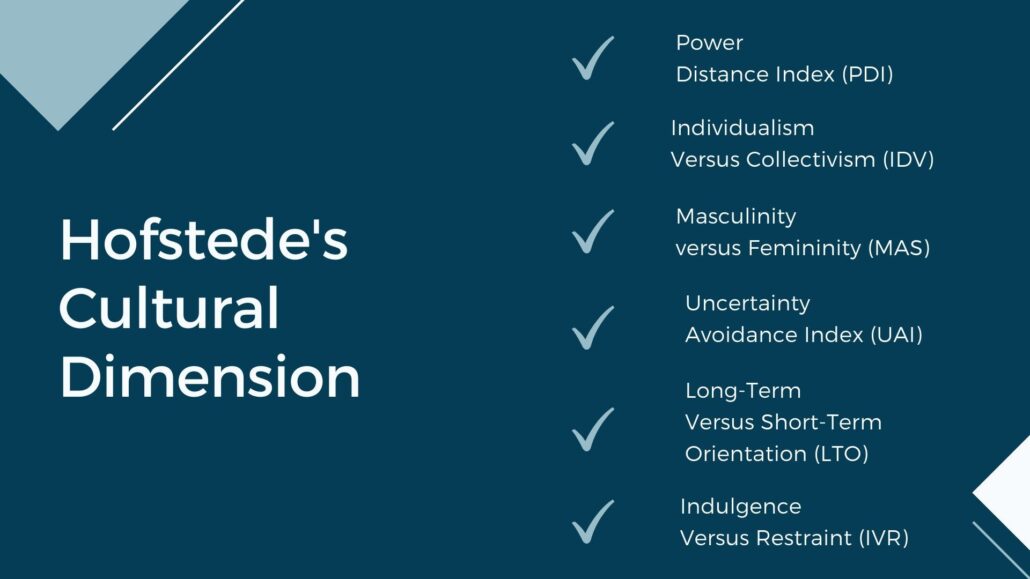Hofstede’s power-distance dimension focuses on the level at which power and inequality are tolerated. The power distance dimension views power and inequality from the lower level or the followers’ point of view. The high power distance culture allows inequality and power differences and promotes absolute respect for those in authority and bureaucracy (Hofstede’s Power Distance Dimension).

Consequently, lower power distance promotes flat organizational structures, decentralized management style, participative decision-making, and power distributions (Guo et al., 2020). Power distance varies depending on different nations and their culture. Therefore, organizational leaders should understand the power distance concept to promote effective decision-making and management.
On Hofstede’s power distance dimension, how might a leader from a culture with high power distance best lead those in a low-power distance culture?
High power distance cultures support rigid hierarchy and strong command structure. The leaders are the sole decision-makers in a high power distance culture. In a low-power distance culture, the employees are encouraged to participate and access their leaders easily. Therefore, the best way a leader from a high-power distance culture can lead followers from a low-distance culture is by learning and understanding the low-power distance culture.
Besides exercising absolute authority over the followers, the leader should encourage bilateral feedback with the followers and support experimentation and questioning to promote efficient leadership (Kortsch et al., 2022). The leader should also adopt leadership styles that match the power distance of the followers (Hofstede’s Power Distance Dimension).
By so doing, the leader will avert any possible revolt from the followers that can result when they feel undermined. Cuhadar (2022) asserts that the transformational leadership style is significantly effective in a low-power distance culture. In this case, the transformational leadership approach will be crucial for changing the low-power distance culture followers to conform to the leader’s high-power distance dimension to promote leadership efficiency.
What challenges might a leader from a low-power distance culture have in leading in a high-power distance culture? (Hofstede’s Power Distance Dimension)
Subsequently, a leader from a low-power-distance culture will encounter immense challenges while leading in a high-power-distance culture. The high power distance followers are likely to ignore the low power distance rule (Guo et al., 2020). The leader is also likely to encounter revolts from the followers after making a mistake or after they realize that the leader is not confident enough to make decisions solely (Hofstede’s Power Distance Dimension).
The revolts will also arise since the leader from a low-distance culture needs to create a strong command structure while leading a high-distance culture. Unlike in a low power distance culture, the leader will encounter a challenge in deciding solely on a circumstance they have not encountered before. Thus, a leader is prone to making mistakes since they have the experience to make decisions themselves.
How might Hofstede’s dimensions of gender organizations deal with gender differences in leadership styles and effectiveness?
Hofstede’s gender egalitarianism significantly impacts gender differences in leadership styles and effectiveness. Gender differences stress femininity and masculinity. As such, women should be weak, polite, accommodating, and nurturing, while men should be strong, bold, and aggressive. On the contrary, gender egalitarianism prioritizes equality between men and women (Hofstede’s Power Distance Dimension).
Hofstede’s gender dimension asserts that men’s leadership skills should not be considered more important and powerful than women’s and vice versa (Alvinius, 2017). In this case, the word ‘complementary’ instead of ‘differences’ should be used when describing leadership styles. Therefore, leaders can develop skills that are traditionally linked to their gender. Therefore, women have equal opportunities for leadership positions as men.
References
Alvinius, A. (Ed.). (2017). Contemporary leadership challenges. BoD–Books on Demand.
Cuhadar, S. (2022). LINKING BETWEEN NATIONAL CULTURE AND LEADERSHIP STYLES OF MANAGERS IN ORGANISATIONS: A Case Study. Network Intelligence Studies, Volume X, Issue 20 (2/22). Retrieved from https://seaopenresearch.eu/Journals/articles/NIS_20_3.pdf
Guo, Y., Zhu, Y., & Zhang, L. (2020). Inclusive leadership, leader identification, and employee voice behavior: The moderating role of power distance. Current Psychology, 1-10.
Kortsch, T., Bashenkhaeva, V., & Kauffeld, S. (2022). Learning from leaders: the mediating role of leadership between national culture and organizational learning culture. Human Resource Development International, 1-24.
A Page will cost you $12, however, this varies with your deadline.
We have a team of expert nursing writers ready to help with your nursing assignments. They will save you time, and improve your grades.
Whatever your goals are, expect plagiarism-free works, on-time delivery, and 24/7 support from us.
Here is your 15% off to get started.
Simply:
- Place your order (Place Order)
- Click on Enter Promo Code after adding your instructions
- Insert your code – Get20
All the Best,
Cathy, CS


